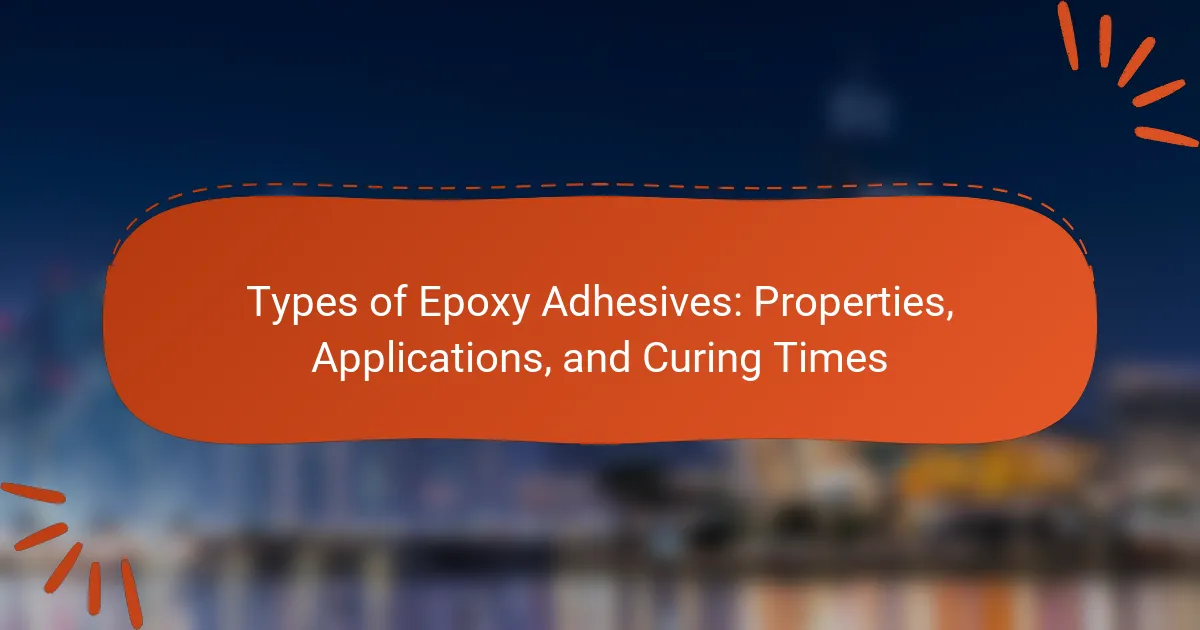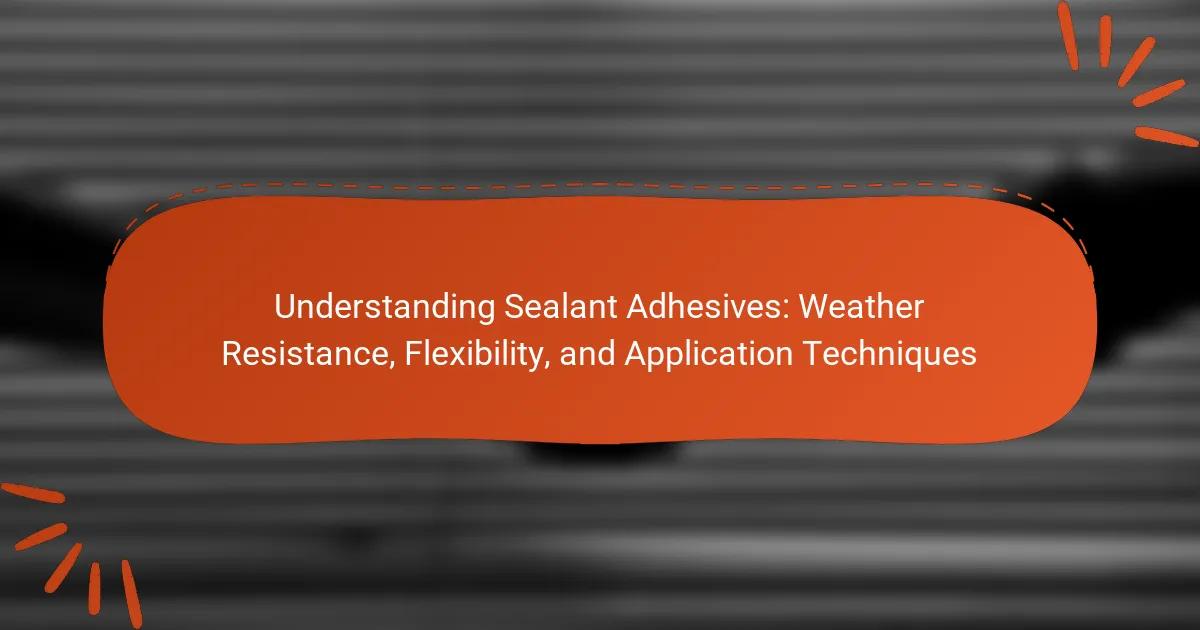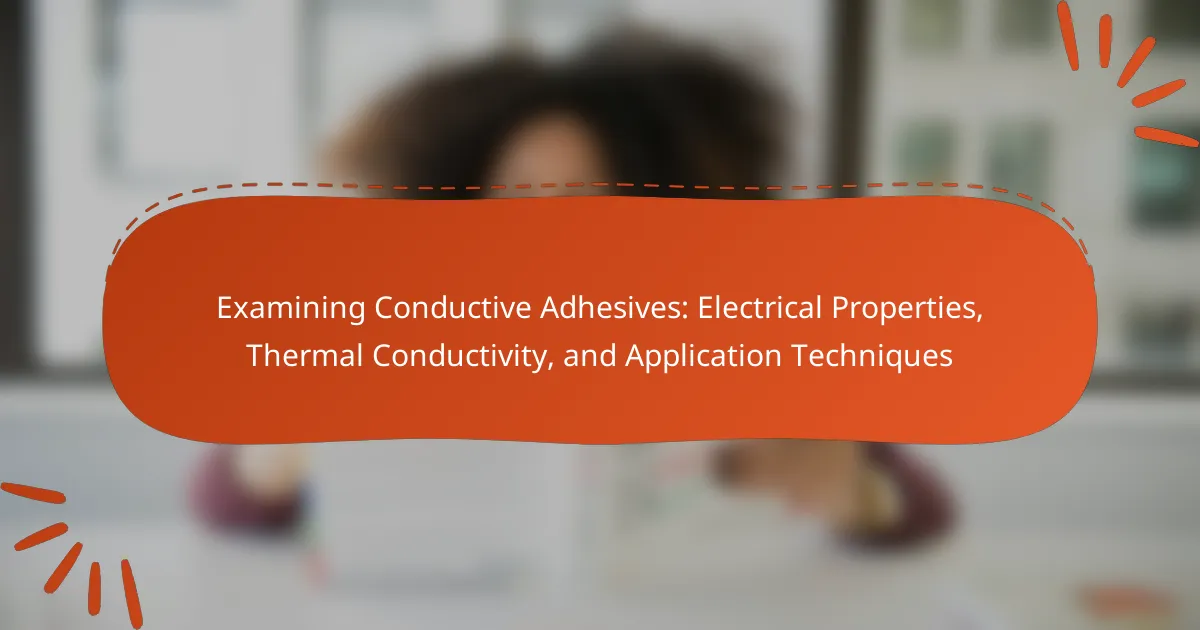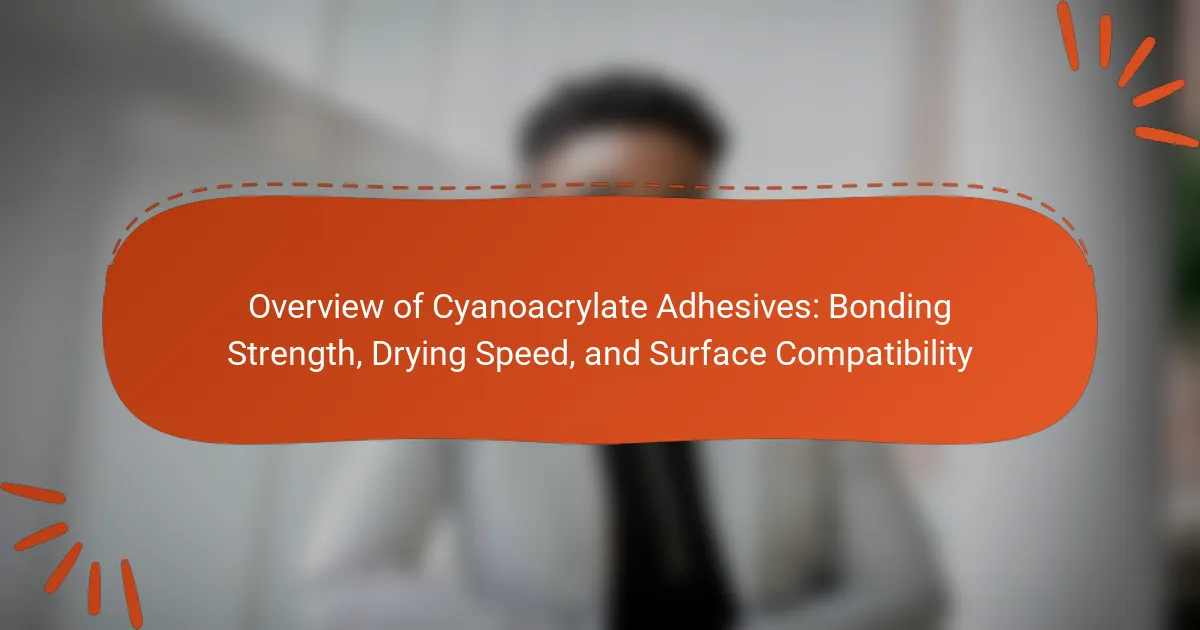Epoxy adhesives are versatile bonding agents known for their strength and durability, used across various industries including construction, automotive, and aerospace. There are three primary types: structural epoxy adhesives, which provide high strength for critical applications; non-structural epoxy adhesives, suitable for less demanding bonds; and flexible epoxy adhesives, designed to allow movement between surfaces. Each type has unique formulations tailored for specific materials and environments, exhibiting excellent adhesion to metals, plastics, and wood. The curing times for these adhesives vary, typically ranging from 5 minutes to 72 hours, influenced by temperature and humidity, making it essential to follow manufacturer guidelines for optimal results.
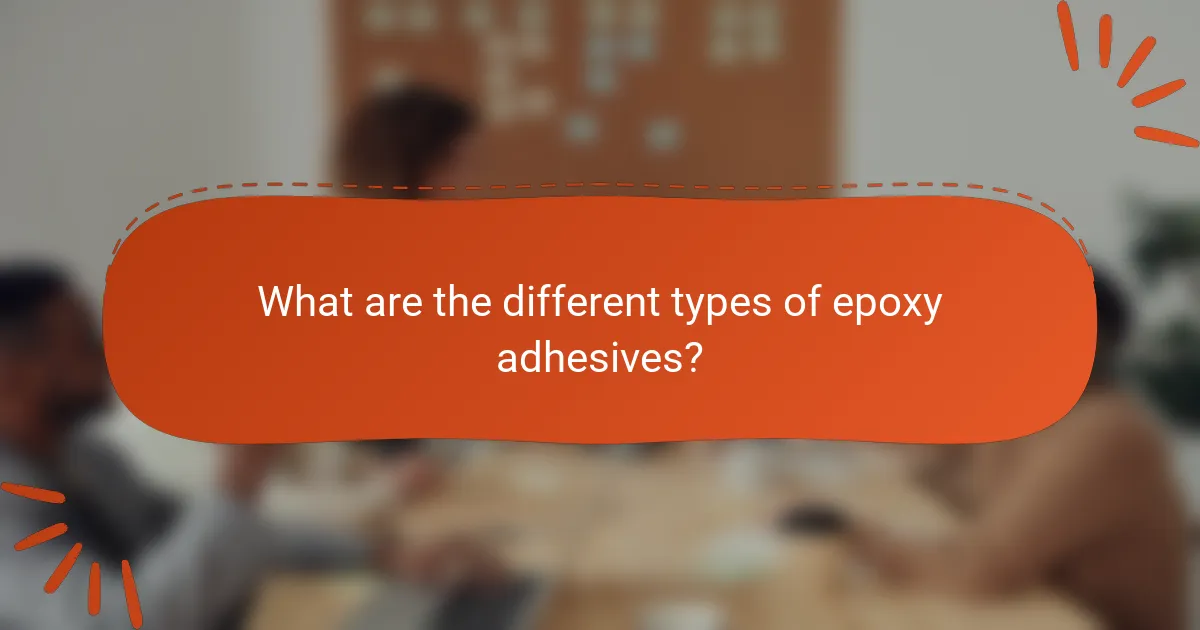
What are the different types of epoxy adhesives?
The different types of epoxy adhesives include structural, non-structural, and flexible epoxy adhesives. Structural epoxy adhesives are designed for high-strength applications. They are commonly used in construction and automotive industries. Non-structural epoxy adhesives are suitable for bonding materials where high strength is not critical. Flexible epoxy adhesives allow for movement between bonded surfaces. They are ideal for applications requiring elasticity. Each type has specific formulations tailored for various materials and environments.
How do the properties of epoxy adhesives vary by type?
The properties of epoxy adhesives vary significantly by type. Different formulations exhibit distinct characteristics such as viscosity, cure time, and tensile strength. For instance, flexible epoxy adhesives provide better elongation, making them suitable for applications requiring movement. Rigid epoxy adhesives, on the other hand, offer higher tensile strength and are ideal for structural bonding.
Some epoxy types are designed for fast curing, allowing for quicker project completion. Others may have longer working times, enabling more precise application. Additionally, specialty epoxies may include additives for enhanced resistance to chemicals or temperature extremes.
The variation in properties is due to the differing resin and hardener combinations used in each epoxy type. These differences dictate their suitability for specific applications, ranging from automotive to construction.
What are the common characteristics of flexible epoxy adhesives?
Flexible epoxy adhesives are known for their strong bonding capabilities and flexibility. They typically exhibit excellent adhesion to various substrates, including metals, plastics, and wood. These adhesives can withstand thermal cycling and mechanical stress without losing their bond integrity. They often have a low viscosity, allowing for easy application and [censured] into joint surfaces. Flexible epoxy adhesives also demonstrate good chemical resistance, making them suitable for harsh environments. Additionally, they cure at room temperature or with heat, offering versatility in application. Their flexibility allows for movement between bonded materials, reducing the risk of cracking or failure under stress.
What distinguishes rigid epoxy adhesives from other types?
Rigid epoxy adhesives are distinguished by their exceptional strength and durability. They cure to form a solid bond that can withstand heavy loads and harsh environmental conditions. Unlike flexible adhesives, rigid epoxies do not allow for movement between bonded surfaces. This makes them ideal for structural applications. They also exhibit excellent chemical resistance, making them suitable for industrial use. Rigid epoxy adhesives typically have longer curing times compared to other types. Their high thermal stability further enhances their performance in demanding applications. Overall, these characteristics set rigid epoxy adhesives apart from other adhesive types.
What are the unique features of high-temperature epoxy adhesives?
High-temperature epoxy adhesives are designed to withstand elevated temperatures without losing their bonding strength. They typically maintain structural integrity at temperatures exceeding 150°C. These adhesives exhibit excellent thermal resistance and can endure thermal cycling. They also offer superior chemical resistance, making them suitable for harsh environments. High-temperature epoxy adhesives cure to form a rigid, durable bond. Their low shrinkage during curing helps maintain bond integrity. These adhesives often have enhanced mechanical properties, such as tensile strength and impact resistance. Their unique formulation allows for versatility in various applications, including aerospace and automotive industries.
What applications are best suited for each type of epoxy adhesive?
Structural epoxy adhesives are best suited for applications requiring high strength and durability. These adhesives are ideal for bonding metals, concrete, and composites. They are commonly used in construction, automotive, and aerospace industries.
Flexible epoxy adhesives work well in applications that require some degree of movement. They are suitable for bonding dissimilar materials and are often used in electronics and automotive assemblies.
High-temperature epoxy adhesives are designed for environments exposed to elevated temperatures. These adhesives are suitable for aerospace and industrial applications where heat resistance is critical.
Low-viscosity epoxy adhesives are ideal for applications needing deep [censured] into substrates. They are often used in wood and furniture assembly for enhanced adhesion.
Fast-curing epoxy adhesives are best for applications requiring quick bonding. They are commonly utilized in repair and maintenance tasks where time is a constraint.
Each type of epoxy adhesive has specific characteristics that make it suitable for various applications, ensuring optimal performance in diverse environments.
In which industries are flexible epoxy adhesives predominantly used?
Flexible epoxy adhesives are predominantly used in the automotive, aerospace, construction, and electronics industries. In the automotive sector, they bond components for durability and resistance to environmental factors. Aerospace applications utilize them for lightweight and strong material connections. In construction, flexible epoxy adhesives are used for flooring and structural bonding. Electronics industries rely on these adhesives for circuit board assembly and potting applications. These industries benefit from the high strength and flexibility of the adhesives, ensuring long-lasting performance under various conditions.
What types of projects benefit from rigid epoxy adhesives?
Rigid epoxy adhesives benefit projects that require strong, durable bonds. These adhesives are ideal for construction applications, such as bonding concrete and masonry. They are also effective in automotive repairs, providing resilience under stress. Manufacturing industries utilize rigid epoxy for assembling components in machinery. Aerospace projects benefit from their high strength-to-weight ratio. Additionally, they are used in electronics for potting and encapsulating sensitive components. Their resistance to chemicals makes them suitable for industrial settings. Overall, rigid epoxy adhesives are essential for projects demanding long-lasting and robust adhesion.
How are high-temperature epoxy adhesives utilized in specialized fields?
High-temperature epoxy adhesives are utilized in specialized fields such as aerospace, automotive, and electronics. In aerospace, they bond materials that endure extreme temperatures and stress. Automotive applications include engine components and exhaust systems requiring high thermal resistance. In electronics, these adhesives provide insulation and protection for circuit boards exposed to heat. Their ability to withstand temperatures exceeding 300°F makes them ideal for these applications. For instance, aerospace-grade epoxy adhesives are tested according to rigorous standards like ASTM D-1002. This ensures reliability under demanding conditions.
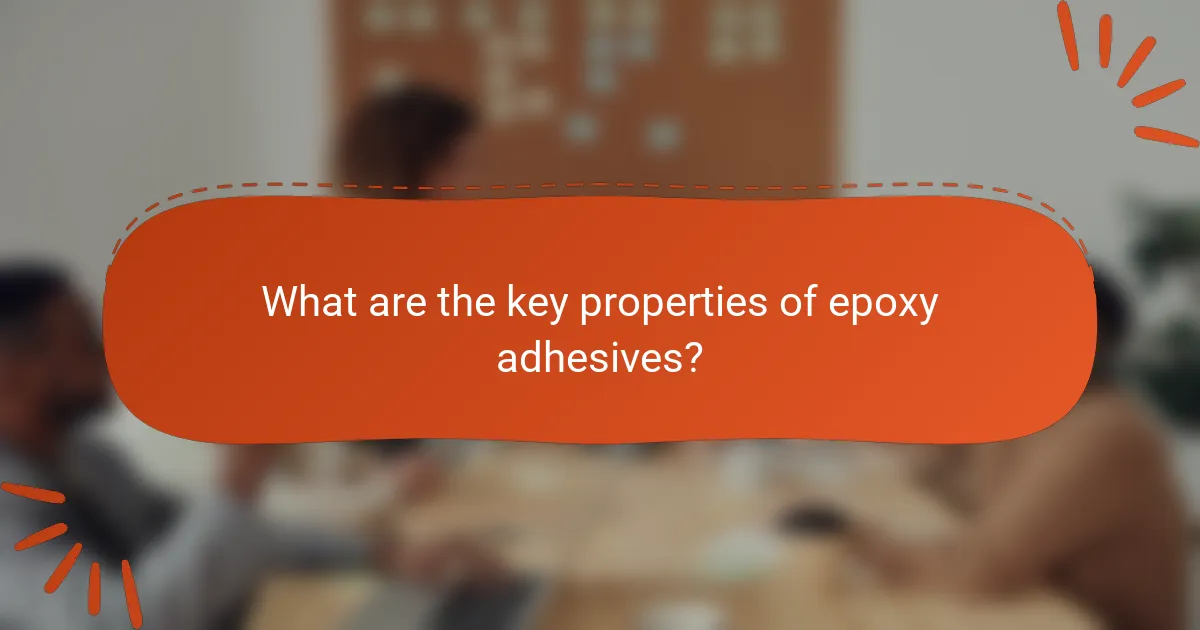
What are the key properties of epoxy adhesives?
Epoxy adhesives are known for their strong bonding capabilities and durability. They exhibit excellent adhesion to a variety of substrates, including metals, plastics, and wood. Epoxy adhesives are resistant to moisture, chemicals, and heat, making them suitable for demanding environments. They also have a low shrinkage rate during curing, which helps maintain bond integrity. The curing process can be tailored to achieve different properties, such as flexibility or hardness. Their mechanical strength is typically higher than that of many other adhesive types. Additionally, epoxy adhesives can be formulated to have specific working times, allowing for varying application needs. These properties make epoxy adhesives widely used in construction, automotive, and aerospace industries.
How does adhesion strength vary among different epoxy adhesives?
Adhesion strength varies significantly among different epoxy adhesives. Factors influencing this variation include the formulation, curing agents, and surface preparation. For instance, structural epoxy adhesives typically offer higher adhesion strength compared to general-purpose formulations. Some industrial-grade epoxies can achieve adhesion strengths exceeding 3000 psi. In contrast, consumer-grade epoxies may only reach around 1000 psi. Additionally, the presence of fillers and additives can enhance or reduce adhesion strength. Testing methods, such as lap shear tests, provide quantifiable measures of adhesion strength for specific epoxy types. These variations highlight the importance of selecting the right epoxy for a given application.
What factors influence the adhesion strength of epoxy adhesives?
The adhesion strength of epoxy adhesives is influenced by surface preparation, curing conditions, and material compatibility. Proper surface preparation enhances the adhesive’s ability to bond. Cleaning, roughening, or priming surfaces increases adhesion by providing a better mechanical interlock. Curing conditions, such as temperature and humidity, affect the epoxy’s chemical structure and performance. Optimal curing leads to stronger bonds. Material compatibility is crucial; dissimilar materials may require specific formulations to ensure effective adhesion. Studies show that the interaction between epoxy and substrates significantly impacts adhesion strength. For instance, a study by K. T. W. Ng and P. K. K. Wong in the Journal of Adhesion Science and Technology highlights the importance of these factors in achieving desired bonding performance.
How does temperature affect the performance of epoxy adhesives?
Temperature significantly affects the performance of epoxy adhesives. Higher temperatures can accelerate the curing process, leading to faster bond formation. However, excessive heat may also compromise the adhesive’s mechanical properties. Lower temperatures slow down curing, potentially resulting in incomplete bonding. According to the American Institute of Chemical Engineers, optimal curing temperatures typically range from 60°F to 90°F. Deviating from this range can lead to reduced strength and durability. Epoxy adhesives exposed to extreme temperatures may also experience increased brittleness or flexibility. Therefore, maintaining appropriate temperature conditions is crucial for achieving optimal adhesive performance.
What role does viscosity play in the effectiveness of epoxy adhesives?
Viscosity significantly influences the effectiveness of epoxy adhesives. Higher viscosity can enhance the adhesive’s ability to fill gaps and create a strong bond. It allows for better control during application, reducing the risk of drips and runs. Conversely, lower viscosity can improve [censured] into surfaces, ensuring a more thorough adhesion. The right viscosity is essential for optimal performance in specific applications. Studies have shown that adjusting viscosity can directly affect bond strength and durability. For example, a viscosity range of 1000 to 5000 cP is often ideal for structural bonding. This range provides a balance between workability and adhesion performance.
How does viscosity impact application and curing time?
Viscosity significantly affects both the application and curing time of epoxy adhesives. Higher viscosity adhesives are thicker and more challenging to spread. This can lead to longer application times as they require more effort to apply evenly. Conversely, lower viscosity adhesives are easier to spread and can be applied more quickly.
Curing time is also influenced by viscosity. Higher viscosity formulations often cure more slowly due to limited mobility of the reactive components. This means that the chemical reactions necessary for curing take longer to occur. In contrast, lower viscosity adhesives tend to cure faster because the components can interact more freely.
Research shows that viscosity directly correlates with the rate of reaction in epoxy systems. For example, a study published in the Journal of Adhesion Science and Technology noted that viscosity impacts the diffusion rate of reactive species, affecting curing speed. Thus, understanding viscosity is crucial for optimizing the use of epoxy adhesives in various applications.
What are the implications of viscosity on bonding surfaces?
Viscosity significantly affects bonding surfaces in epoxy adhesives. Higher viscosity can lead to reduced flow and wetting of surfaces. This can result in inadequate surface coverage and weak bonds. Conversely, lower viscosity allows better [censured] into surface irregularities. This improves adhesion and overall bond strength. Studies show that optimal viscosity enhances the performance of epoxy adhesives. For example, a viscosity range of 1000-3000 cP is often ideal for effective bonding. Thus, viscosity directly influences the effectiveness of epoxy adhesives in various applications.
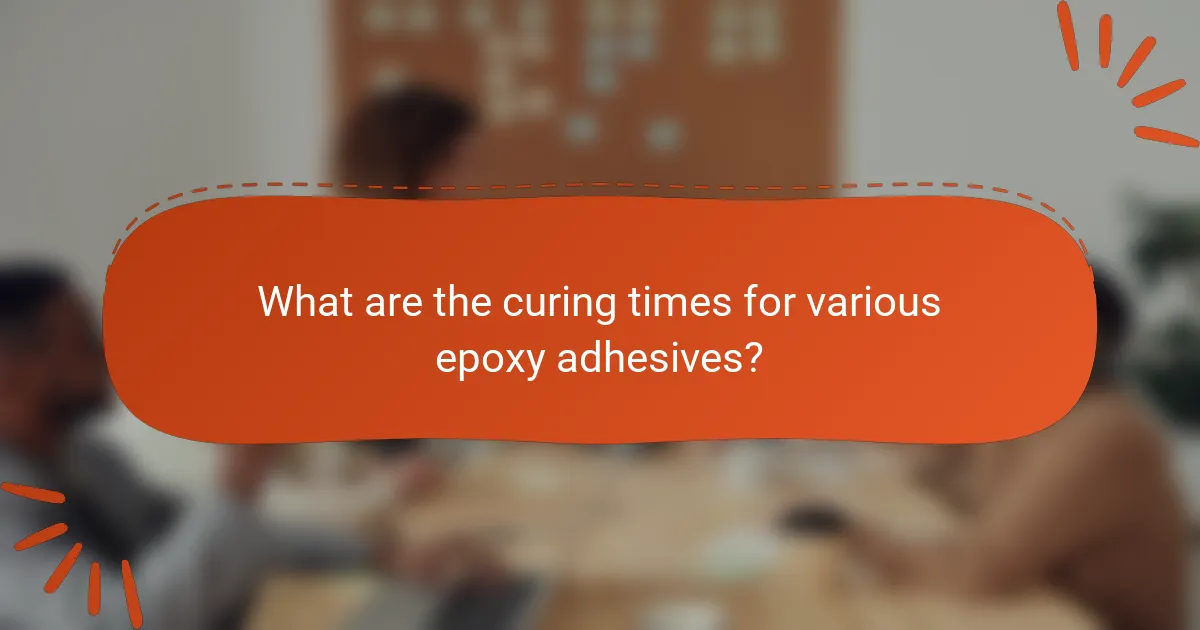
What are the curing times for various epoxy adhesives?
Curing times for various epoxy adhesives typically range from 5 minutes to 24 hours. Fast-curing epoxy adhesives can set in as little as 5 to 15 minutes. Standard epoxy adhesives usually require 4 to 6 hours for initial set and 24 hours for full cure. Some specialty epoxies may take longer, up to 72 hours, to achieve maximum strength. Temperature and humidity can significantly affect curing times. Higher temperatures generally accelerate curing, while lower temperatures can prolong it. The specific manufacturer’s instructions should always be followed for accurate curing times.
How do curing times differ among types of epoxy adhesives?
Curing times among types of epoxy adhesives vary significantly based on their formulation. Standard epoxy adhesives typically cure within 24 hours at room temperature. Fast-curing epoxy adhesives can set in as little as 5 to 30 minutes. Conversely, slow-curing epoxies may take up to several days to fully cure. The temperature and humidity can also affect curing times, with higher temperatures generally speeding up the process. Additionally, some specialty epoxies are designed for specific applications and may have unique curing characteristics. For example, underwater epoxies are formulated to cure effectively in wet conditions.
What factors can affect the curing time of epoxy adhesives?
The curing time of epoxy adhesives can be affected by several factors. Temperature significantly influences the curing process. Higher temperatures generally accelerate curing, while lower temperatures slow it down. Humidity levels also play a role; excessive moisture can hinder the curing of certain epoxy formulations. The specific formulation of the epoxy adhesive can impact its curing time as well. Different hardeners or catalysts can either speed up or slow down the curing process. Additionally, the thickness of the adhesive layer affects curing; thicker layers may take longer to cure completely. Surface preparation, such as cleanliness and roughness, can also influence curing efficiency. These factors collectively determine the overall curing time of epoxy adhesives.
How does ambient temperature influence curing times?
Ambient temperature significantly influences curing times of epoxy adhesives. Higher temperatures generally accelerate the curing process. For instance, at 70°F (21°C), curing may take 24 hours. However, at 90°F (32°C), this time can reduce to 10 hours. Conversely, lower temperatures can prolong curing times. At 50°F (10°C), curing can take up to 48 hours. This temperature sensitivity is due to the increased molecular activity at higher temperatures, which promotes chemical reactions. Studies show that each 10°F increase can halve the curing time. Therefore, managing ambient temperature is crucial for optimal epoxy adhesive performance.
What are the best practices for curing epoxy adhesives?
The best practices for curing epoxy adhesives include maintaining optimal temperature and humidity levels. Epoxy adhesives typically cure best at temperatures between 70°F and 90°F. High humidity can negatively affect the curing process, leading to weaker bonds.
Mixing the epoxy components thoroughly is essential for proper curing. Inadequate mixing can result in uncured areas within the adhesive. It is also important to follow the manufacturer’s recommended curing time, which can vary by product.
Applying the adhesive in thin layers can facilitate better curing, as thicker applications may trap air and moisture. Using a heat source can accelerate the curing process, but care should be taken to avoid overheating.
Finally, allowing the epoxy to cure undisturbed is crucial for achieving maximum strength. Movement or stress during the curing phase can compromise the bond’s integrity.
How can proper curing enhance the performance of epoxy adhesives?
Proper curing significantly enhances the performance of epoxy adhesives. Curing allows the epoxy to undergo a chemical reaction that increases its strength and durability. This process transforms the adhesive from a liquid state to a solid, fully bonded material. Proper curing ensures optimal cross-linking between the resin and hardener. Enhanced cross-linking results in improved mechanical properties, such as tensile strength and impact resistance. Additionally, well-cured epoxy adhesives exhibit better resistance to chemicals and environmental factors. Research indicates that curing at recommended temperatures and times maximizes adhesive performance. For example, a study published in the Journal of Adhesion Science and Technology highlights that proper curing can increase bond strength by up to 50%.
What tips can ensure optimal curing conditions for epoxy adhesives?
Maintain a stable temperature between 65°F to 95°F for optimal curing of epoxy adhesives. This temperature range allows the epoxy to cure effectively. Ensure the workspace is well-ventilated to facilitate proper curing. Humidity levels should be kept low, ideally below 70%, as high humidity can hinder the curing process. Mix the epoxy components thoroughly according to the manufacturer’s instructions to ensure a proper chemical reaction. Avoid applying the adhesive in direct sunlight to prevent uneven curing. Allow adequate time for curing, typically 24 hours for initial set and up to several days for full strength. Following these guidelines ensures the epoxy achieves its maximum bonding potential.
What troubleshooting tips can help with epoxy adhesive applications?
Ensure surfaces are clean and dry before application. Contaminants can prevent proper bonding. Mix epoxy resin and hardener thoroughly according to the manufacturer’s instructions. Incomplete mixing can lead to weak joints. Apply the adhesive within the recommended working time. Working too late can cause curing issues. Use the correct temperature range for application. Epoxy typically cures best between 60°F to 90°F. If bubbles appear, apply heat gently to release them. Inspect for proper cure time before stress testing the bond. Proper curing ensures maximum strength.
How can common curing problems be resolved?
To resolve common curing problems with epoxy adhesives, ensure proper mixing ratios. Incorrect ratios can lead to incomplete curing. Use a digital scale for accuracy when measuring components. Maintain optimal temperature and humidity levels during curing. Epoxy typically cures best at temperatures between 70°F and 90°F. If curing is slow, consider using a heat source to increase the temperature. For issues like bubbling, degas the mixture before application. Allow sufficient time for curing as specified by the manufacturer. Following these steps can significantly improve the curing process.
What should be done if adhesion fails during application?
If adhesion fails during application, the surface must be prepared again. Clean the area thoroughly to remove contaminants. Ensure that the surface is dry and free from dust or grease. Apply the epoxy adhesive according to the manufacturer’s instructions. Allow adequate curing time as specified. If issues persist, consider using a different type of epoxy adhesive. Testing on a small area can help determine compatibility. Proper surface preparation is crucial for effective adhesion.
The main entity of the article is epoxy adhesives, which are categorized into structural, non-structural, flexible, and high-temperature types, each with distinct properties and applications. The article explores the varying characteristics of these adhesives, such as adhesion strength, viscosity, and curing times, highlighting their suitability for different industries including automotive, aerospace, and construction. It also delves into best practices for application and curing, troubleshooting tips, and the impact of temperature and humidity on performance. Overall, the content provides a comprehensive overview of epoxy adhesives, emphasizing their properties, applications, and the importance of proper curing for optimal performance.
